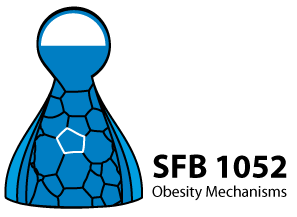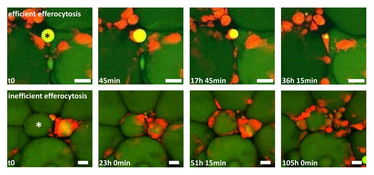B9 - Rolle von Makrophagen bei der Degradation von Adipozyten
Das angeborene Immunsystem dient, neben der Abwehr von Mikroorganismen, auch der Gewebehomöostase. Täglich werden 200 - 300 Milliarden sterbender Zellen im Körper von Zellen des angeborenen Immunsystems erkannt und abgeräumt. Das Fettgewebe besteht hauptsächlich aus Fettzellen. Darüber hinaus kommen im Fettgewebe auch Makrophagen vor, die sogenannten Fettgewebemakrophagen. Interessanterweise sind Fettzellen um ein vielfaches größer als Makrophagen und können im Alter oder bei falscher Ernährung die 5-fache Dimension von regulären Makrophagen erreichen. Die Abräumreaktion kann daher nicht von einzelnen Makrophagen bewerkstelligt werden. Ziel dieses Forschungsprojektes ist es, die zellulären und molekularen Vorgänge nach dem Sterben von Fettzellen zu untersuchen. Hierfür wurden von uns verschiedene ex vivo (Laser-induzierter Zelltod) und in vivo Modelle entwickelt (transgene Expression von Todesrezeptoren auf Adipozyten), um Adipozyten im lebenden Gewebe gezielt abzutöten. Im speziellen Fokus steht hier die extrazelluläre Verdauung durch lysosomale Exozytose. Hierbei sollen pharmakologische Ansatzpunkte gefunden werden, um die Abräumreaktion toter Fettzellen im Rahmen der Adipositas zu verbessern.
Abbildung 1: Lebendmikroskopie von Fettgewebe zeigt unterschiedliche Abbauvorgänge von sterbenden Fettzellen durch Fettgewebemakrophagen. Die Darstellung zeigt lebendes Fettgewebe mit rot-leuchtenden Makrophagen und grün-gefärbten Fettzellen. Obere Bildreihe: Ausschnitte eines Videos zeigen, wie ein Makrophage innerhalb von ~36 h eine sterbende Fettzelle (mit Stern markiert) erkennt, aufnimmt und verdaut. Untere Bildreihe: Nach erstem Kontakt zwischen sterbender Fettzelle und Makrophagen werden eine große Anzahl von weiteren Makrophagen angelockt und umschließen gemeinschaftlich die sterbende Fettzelle, ohne Anzeichen von Abbau der Fettzelle innerhalb von 4 Tagen. Messbalken entspricht 50 µm.
Krieg L, Didt K, Karkossa I, Bernhart SH, Kehr S, Subramanian N, Lindhorst A, Schaudinn A, Tabei S, Keller M, Stumvoll M, Dietrich A, von Bergen M, Stadler PF, Laurencikiene J, Krüger M, Blüher M, Gericke M, Schubert K, Kovacs P, Chakaroun R, Massier L. Gut. 2021 Oct 1:gutjnl-2021-324603.
Lindhorst A, Raulien N, Wieghofer P, Eilers J, Rossi FMV, Bechmann I, Gericke M. Adipocyte death triggers a pro-inflammatory response and induces metabolic activation of resident macrophages. Cell Death Dis . 2021 Jun 5;12(6):579.
Brinker G, Froeba J, Arndt L, Braune J, Hobusch C, Lindhorst A, Bechmann I, Gericke M. CD4+ T cells regulate glucose homeostasis independent of adipose tissue dysfunction in mice. Eur J Immunol. 2021 Mar 30.
Kunath A, Weiner J, Krause K, Rehders M, Pejkovska A, Gericke M, Biniossek ML, Dommel S, Kern M, Ribas-Latre A, Schilling O, Brix K, Stumvoll M, Klöting N, Heiker JT, Blüher M. Role of Kallikrein 7 in Body Weight and Fat Mass Regulation. Biomedicines 2021, 9, 131.
Landgraf K, Klöting N, Gericke M, Maixner N, Guiu-Jurado E, Scholz M, Witte AV, Beyer F, Schwartze JT, Lacher M, Villringer A, Kovacs P, Rudich A, Blüher M, Kiess W, Körner A.The Obesity-Susceptibility Gene TMEM18 Promotes Adipogenesis through Activation of PPARG. Cell Rep. 2020;33(3):108295.
Lindhorst A, Bechmann I, Gericke M. Unspecific DNA recombination in AdipoqCre-ERT2 – mediated knockout approaches in transgenic mice is sex-, age- and genotype-dependent. Adipocyte 2020 Dec;9(1):1-6.
Braune J, Lindhorst A, Fröba J, Hobusch C, Kovacs P, Blüher M, Eilers J, Bechmann I, Gericke M. Multinucleated Giant Cells in Adipose Tissue are Specialized in Adipocyte Degradation. Diabetes. 2020:db200293.
Schleinitz D, Krause K, Wohland T, Gebhardt C, Linder N, Stumvoll M, Blüher M, Bechmann I, Kovacs P, Gericke M, Tönjes A. Identification of distinct transcriptome signatures of human adipose tissue from fifteen Depots. Eur J Hum Genet. 2020 Jul 13.
Dommel S, Berger C, Kunath A, Kern M, Gericke M, Kovacs P, Guiu-Jurado E, Klöting N, Blüher M. The Fabp4-Cre-model is insufficient to study Hoxc9 function in adipose tissue. Biomedicines . 2020 Jun 29;8(7):E184.
Schopow N, Kallendrusch S, Gong S, Rapp F, Körfer J, Gericke M, Spindler N, Josten C, Langer S, Bechmann I. Examination of Ex-Vivo Viability of Human Adipose Tissue Slice Culture. PLoS One. 2020 May 26;15(5):e0233152.
Massier L, Chakaroun R, Tabei S, Crane A, Didt KD, Fallmann J, von Bergen M, Haange SB, Heyne H, Stumvoll M, Gericke M, Dietrich A, Blüher M, Musat N, Kovacs P. Adipose tissue derived bacteria are associated with inflammation in obesity and type 2 diabetes. Gut. 2020 Apr 21. pii: gutjnl-2019-320118.
Piotrowska A, Winter K, Carare RO, Bechmann I. Vital Functions Contribute to the Spread of Extracellular Fluids in the Brain: Comparison Between Life and Death. Front Aging Neurosci. 2020 Feb 11;12:15.
Zhao S, Todorov MI, Cai R, -Maskari RA, Steinke H, Kemter E, Mai H, Rong Z, Warmer M, Stanic K, Schoppe O, Paetzold JC, Gesierich B, Wong MN, Huber TB, Duering M, Bruns OT, Menze B, Lipfert J, Puelles VG, Wolf E, Bechmann I, Ertürk A. Cellular and Molecular Probing of Intact Human Organs. Cell. 2020 Feb 20;180(4):796-812.e19.
Streit WJ, Khoshbouei H, Bechmann I. Dystrophic microglia in late-onset Alzheimer's disease. Glia. 2020 Apr;68(4):845-854.
Hadadi-Bechor S, Haim Y, Pecht T, Gat R, Tarnovsky T, Gericke M, Rudich A. Autophagy differentially regulates macrophage lipid handling depending on the lipid substrate (oleic acid vs. acetylated-LDL) and inflammatory activation state. Biochim Biophys Acta Mol Cell Biol Lipids. 2019 Sep 11:158527
García-Cáceres C, Balland E, Prevot V, Luquet S, Woods SC, Koch M, Horvath TL, Yi CX, Chowen JA, Verkhratsky A, Araque A, Bechmann I, Tschöp MH. Role of astrocytes, microglia, and tanycytes in brain control of systemic metabolism. Nat Neurosci. 2019 Jan;22(1):7-14.
Joost E, Jordão MJC, Mages B, Prinz M, Bechmann I, Krueger M. Microglia contribute to the glia limitans around arteries, capillaries and veins under physiological conditions, in a model of neuroinflammation and in human brain tissue. Brain Struct Funct. 2019 Jan 31.
Streit WJ, Braak H, Del Tredici K, Leyh J, Lier J, Khoshbouei H, Eisenlöffel C, Müller W, Bechmann I. Microglial activation occurs late during preclinical Alzheimer's disease. Glia. 2018 Nov 11.
Haimon Z, Volaski A, Orthgiess J, Boura-Halfon S, Varol D, Shemer A, Yona S, Zuckerman B, David E, Chappell-Maor L, Bechmann I, Gericke M, Ulitsky I, Jung S., Re-evaluating microglia expression profiles using RiboTag and cell isolation strategies. Nat Immunol. 2018 May 18.
Zieger K, Weiner J, Kunath A, Gericke M, Krause K, Kern M, Stumvoll M, Klöting N, Blüher M, Heiker JT. Ablation of kallikrein 7 (KLK7) in adipose tissue ameliorates metabolic consequences of high-fat diet induced obesity by counteracting adipose tissue inflammation in vivo. Cell Mol Life Sci. 2017; Epub ahead of print.
Braune J, Weyer U, Hobusch C, Mauer J, Brüning J, Bechmann I, Gericke M. IL-6 regulates M2 polarization and local proliferation of adipose tissue macrophes in obesity. J Immunol. 2017;198:2927-34.
Braune J, Weyer U, Matz-Soja M, Hobusch C, Kern M, Kunath A, Klöting N, Kralisch S, Blüher M, Gebhardt R, Zavros Y, Bechmann I, Gericke M. Hedgehog sinaling in myeloid cells impacts on body weight, adipose tissue inflammation and glucose metabolism. Diabetologia. 2017;60:889-99.
Orthgiess J, Gericke M, Immig K, Schulz A, Hirrlinger J, Bechmann I, Eilers J. Neurons exhibit Lyz2 promotor activity in vivo: Implications for using LysM-Cre mice in myeloid cell research. Eur J Immunol. 2016;46:1529-32.
Haim Y, Blüher M, Slutsky N, Goldstein N, Klöting N, Harman-Boehm I, Kirshstein B, Ginsberg D, Gericke M, Guiu Jurado E, Kovsan J, Tarnovscki T, Kachko L, Bashan N, Gepner Y, Shai I, Rudich A. Elevated autophagy gene expression in adipose tissue of humans: A potential non-cell-cycle-dependent function of E2F1. Autophagy. 2015;11:2074-88.
du Plessis J, van Pelt J, Korf H, Mathieu C, van der Schueren B, Lannoo M, Oyen T, Topal B, Fetter G, Nayler S, van der Merwe T, Windmolders P, van Gaal L, Verrijken A, Hubens G, Gericke M, Cassiman D, Francque S, Nevens F, van der Merwe S. Association of adipose tissue inflammation with histological severity of non-alcoholic fatty liver disease. Gastroenterology. 2015;149:635-48.
Gericke M, Weyer U, Braune J, Bechmann I, Eilers J. A method for long-term live-imaging of tissue macrophages in adipose tissue explants. Am J Physiol Endocrinol Metab. 2015;308:E1023-33.
Kosacka J, Kern M, Klöting N, Paeschke S, Rudich A, Haim Y, Gericke M, Serke H, Stumvoll M, Bechmann I, Nowicki M, Blüher M. Autophagy in adipose tissue of patients with obesity and type 2 diabetes. Mol Cell Endocrinol. 2015;409:21-32.
Immig K, Gericke M, Menzel F, Merz F, Krueger M, Schiefenhövel F, Lösche A, Jäger K, Hanisch UK, Biber K, Bechmann I. CD11c-positive cells from brain, spleen, lung and liver exhibit site-specific immune phenotypes and plastically adapt to new environments. Glia. 2015;63:11-25.
Haase J, Weyer U, Immig K, Klöting N, Blüher M, Eilers J, Bechmann I, Gericke M. Local proliferation of macrophages in adipose tissue during obesity-induced inflammation. Diabetologia. 2014;57:562-71.
Gericke M, Schröder T, Kosacka J, Nowicki M, Klöting N, Spanel-Borowski K. Neuropeptide Y impairs insulin-stimulated translocation of glucose transporter 4 in 3T3-L1 adipocytes through the Y1 receptor. Mol Cell Endocrinol. 2012;348:27-32.
Prodinger C, Bunse J, Krüger M, Schiefenhövel F, Brandt C, Laman JD, Greter M, Immig K, Heppner F, Becher B, Bechmann I. CD11c-expressing cells reside in juxtavascular parenchyma and extend processes into the glia limitans of the mouse nervous system. Acta Neuropathol. 2011;121:445-58.
Gericke M, Kosacka J, Koch D, Nowicki M, Schröder T, Ricken AM, Nieber K, Spanel-Borowski K. Receptors for NPY and PACAP differ in expression and activity during adipogenesis in the murine 3T3-L1 fibroblast cell line. Br J Pharmacol. 2009;157:620-32.



